
Chives, scientific name Allium schoenoprasum, is a species of flowering plant in the family Amaryllidaceae that produces edible leaves and flowers.
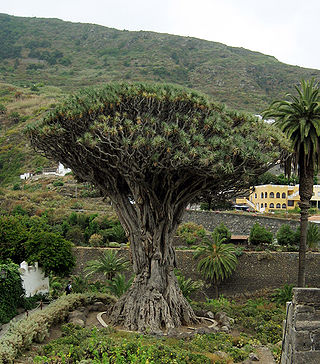
Dracaena draco, the Canary Islands dragon tree or drago, is a subtropical tree in the genus Dracaena, native to the Canary Islands, Cape Verde, Madeira, western Morocco, and possibly introduced into the Azores.

Laurus azorica, the Azores laurel or Macaronesian laurel, is a small, evergreen tree in the laurel family (Lauraceae), found only on the Azores island group in the North Atlantic.
Mesogyne insignis is a species of flowering plants in the family Moraceae. It is the sole species in genus Mesogyne. It is a tree native to the island of São Tomé in the Gulf of Guinea and to eastern Tanzania.
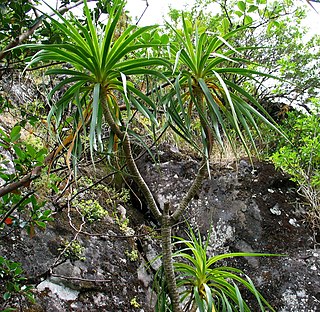
Dracaena forbesii, synonym Pleomele forbesii, is a species of flowering plant that is endemic to the island of Oʻahu in Hawaiʻi. It inhabits dry, coastal mesic and mixed mesic forests at elevations of 240–730 metres (790–2,400 ft). It is threatened by habitat loss.

Dracaena halapepe, synonym Pleomele halapepe, the royal hala pepe, is a species of flowering plant that is endemic to the island of Oʻahu in Hawaiʻi. It inhabits dry, coastal mesic and mixed mesic forests at elevations of 180–610 metres (590–2,000 ft). It is threatened by habitat loss.
Convolvulus semhahensis is a species of plant in the family Convolvulaceae. It is endemic to the island of Samhah in Yemen's Socotra Archipelago. It grows in open dwarf shrubland with Atriplex griffithii from 100 to 200 metres elevation.
Convolvulus kossmatii is a species of plant in the family Convolvulaceae. It is endemic to the island of Abd al Kuri in the Socotra archipelago of Yemen. Its natural habitat is subtropical or tropical dry shrubland.
Synsepalum aubrevillei is a species of plant in the family Sapotaceae. It is found in Côte d'Ivoire and Ghana in wet, tropical biomes, and is threatened by habitat loss.
Terminalia reitzii is a species of plant in the Combretaceae family. It is endemic to Brazil, growing primarily in seasonally dry tropical forests in the southern part of the country. It is threatened by habitat loss.
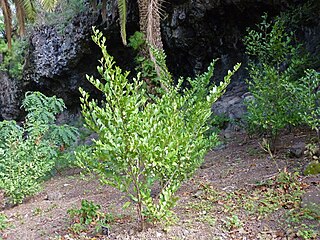
Visnea is a monotypic genus of flowering plants in family Pentaphylacaceae. The genus contains a single species, Visnea mocanera a tree native to the Canary Islands and Madeira.
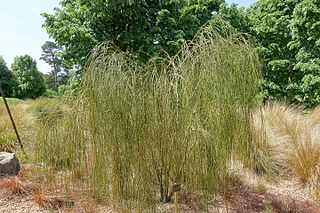
Carmichaelia stevensonii, the cord broom or weeping broom, is a species of plant in the family Fabaceae. It is found only in the north east of the South Island of New Zealand. It is threatened by habitat loss.

Quercus brantii, Brant's oak, is a species of oak native to Western Asia, mainly in Iran, Iraq, Syria, and Turkey.
Plants of the World Online (POWO) is an online database published by the Royal Botanic Gardens, Kew. It was launched in March 2017 with the ultimate aim being "to enable users to access information on all the world's known seed-bearing plants by 2020". This was Kew's answer to the "2020 target 1" of the Convention on Biological Diversity (CBD): "an online flora for all known plants."
Erodium astragaloides is a species of flowering plant in the geranium family Geraniaceae. It is endemic to Sierra Nevada, southern Spain.
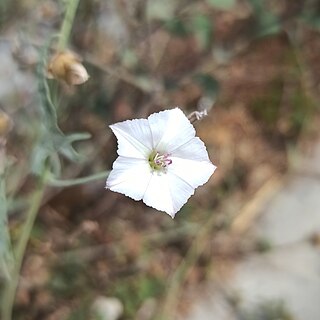
Convolvulus equitans, commonly known as Texas bindweed, is a species of morning glory. It is native to the central and western United States and Mexico. Its overlapping petals give C. equitans its name; equitans being Latin for "riding on horseback".
Convolvulus aschersonii is a species of plant in the family Convolvulaceae. It is native to much of continental Africa as well as Madagascar.
Convolvulus erinaceus is a species of plant in the family Convolvulaceae. It is native to the Central Asia and the Near East.

Convolvulus farinosus is a species of plant in the family Convolvulaceae. It is native to sub-Saharan Africa.










